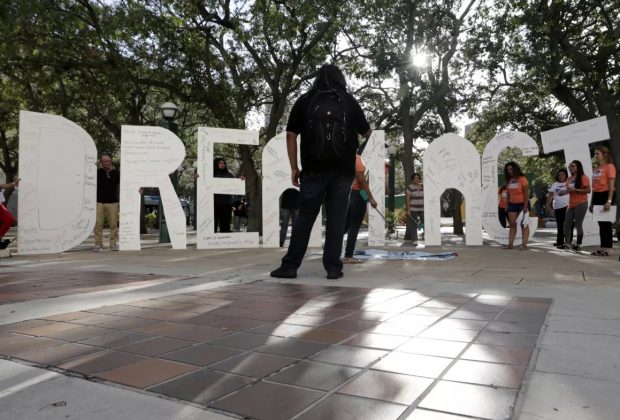Bills to give legal residency to immigrants brought to U.S. as children have been floating around Congress for more than two decades.
Column by Michael Smolens | The San Diego Union-Tribune | FEB. 15, 2023 | Photo by Lynne Sladky
You have to give backers of the Dream Act this: They don’t quit.
They’ve been unsuccessful for more than two decades at gaining protections for immigrants brought to the United States illegally as children.
Further, prospects do not appear good for any major immigration-related legislation getting out of both the House of Representatives, with its new Republican majority, and the Democratic-controlled Senate.
Republicans even stumbled on their own border security measures that GOP leaders were confident they could rush through the House in the first couple of weeks of the new Congress.
Nevertheless, another version of the Dream Act was introduced late last week by Sens. Dick Durbin, D-Ill., and Lindsey Graham, R-S.C., who have teamed up on this before. Neither sounded very optimistic they would achieve a different result.
Actually, it was a bit surprising that the bill was put forward at all. In an end-of-session move, lawmakers in December circulated a proposal for the so-called “dreamers” as sort of a Hail Mary, the thinking being chances were at least a little better then with Democrats holding slim majorities in the House and Senate.
But there’s always pragmatic and perhaps inspirational value in keeping the proposal alive. While it’s hard to imagine, political dynamics could always change in the Dream Act’s favor. It also never hurts to keep the popular proposal in the public eye, given it’s widely believed to be in the best interests of the country, according to polls and economic research.
Not to be lost in all of this is the fate of the nearly 2 million people who could get on the road to citizenship under the Dream Act. For many of them, the U.S. is the only home they’ve known. A subset of some 600,000 of these people have temporary legal status under the Deferred Action for Childhood Arrivals, which appears to be on borrowed time. A federal appellate court in October ruled the program is illegal and must have authorization by Congress.
President Barack Obama created DACA through executive action in 2012.
Both the Dream Act and DACA have broad support, but a Gallup poll released this week suggests the public is increasingly unhappy about immigration overall. The survey revealed that just 28 percent of respondents were satisfied with immigration levels — the lowest percentage measured by Gallup since 2012, according to U.S. News & World Report.
For years, the Dream Act appeared to have enough bipartisan support in Congress that a standalone bill could become law. But immigration politics aren’t that simple, with both Republicans and Democrats often wanting to attach other proposals.
The basic gist of the bill is familiar: People who were brought to the United States illegally as children and have a high school diploma (or GED), pursue higher education, work for at least three years or serve in the military could gain legal residency and, eventually, citizenship.
They also must pass a background check, pay a fee, be proficient in English and U.S. history, and have not committed a serious crime.
The proposal was among a recent string of immigration-related developments. A few days before it was introduced, President Joe Biden briefly addressed immigration in his State of the Union speech. Subsequently, administration officials told news organizations they were in talks with Mexico about accepting non-Mexican deportees from the U.S..
On Monday, Rep. Kevin McCarthy, R-Bakersfield, announced he will make his first trip to the border as House speaker later in the week, when he plans to lead a small delegation of new GOP House members on an aerial tour over Arizona.
During last year’s election campaign and since, Republicans have emphasized the increase in attempted crossings to buttress their claim that the Biden administration has lost control of the southern border.
Many Republicans are demanding that the first order of business be for the federal government to “secure the border” with Mexico. What that means is not entirely clear. If taken literally, it may be an impossible standard to meet.
One of the stalled GOP bills uses the term “operational control” of the border and refers to the definition in the Secure Fence Act of 2006. That definition focuses on keeping terrorists, drug traffickers and other criminals from entering the United States, but also calls for “the prevention of all unlawful entries. . .”
“I think it’s very forgiving to use the word aspirational. I mean, it’s unrealistic,” Doris Meissner, a former Immigration and Naturalization Service commissioner under President Bill Clinton, told The Hill.
Graham didn’t rely on that definition, but he made clear the Dream Act must be tied to stronger enforcement measures. He said the U.S. must “repair a broken border” before relief for “dreamers” “is remotely possible.”
Biden maintains recent enforcement efforts have shown results.
“We now have a record number of personnel working to secure the border, arresting 8,000 human smugglers and seizing over 23,000 pounds of fentanyl in just the last several months,” he said in his State of the Union address on Feb. 7.
“Since we launched our new border plan last month, unlawful migration from Cuba, Haiti, Nicaragua, and Venezuela has come down 97 percent. But America’s border problems won’t be fixed until Congress acts.”
He urged lawmakers to “at least” pass his proposals for more equipment and officers at the border, and pleaded for a pathway to citizenship for “dreamers” and protections for farm workers and other essential workers who could be subject to deportation.
Republicans were not moved and pointed to recent border data.
U.S. Customs and Border Protection reported 156,274 border encounters in January, slightly more than the 154,874 in January 2022 and much higher than the 78,414 encountered in January 2021, when President Donald Trump left office.
It was the first month in 10 in which border encounters were below 200,000, according to Customs and Border Protection.
It seems unlikely Biden could enact enforcement policies that would satisfy Republicans enough to move forward on any immigration measures beyond their own border security bills. It’s also questionable whether he could keep enough Democrats on board for immigration improvements if they deem any concurrent crackdowns as too severe.
Meanwhile, “dreamers” — with a median age now of 24 — remain in limbo.







